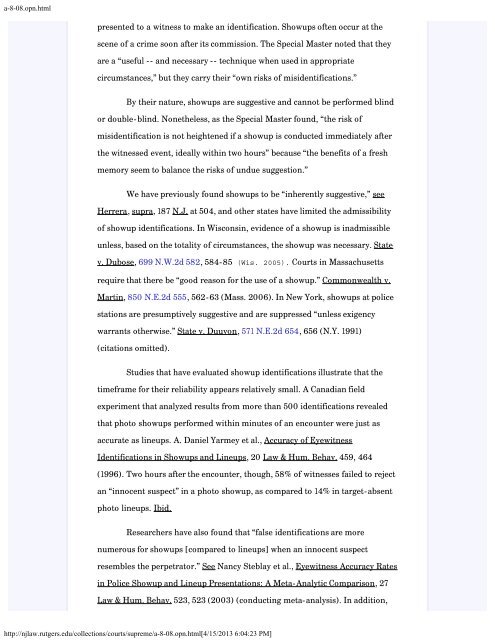State v. Henderson and the New Model Jury Charges - New Jersey ...
State v. Henderson and the New Model Jury Charges - New Jersey ...
State v. Henderson and the New Model Jury Charges - New Jersey ...
You also want an ePaper? Increase the reach of your titles
YUMPU automatically turns print PDFs into web optimized ePapers that Google loves.
a-8-08.opn.html<br />
presented to a witness to make an identification. Showups often occur at <strong>the</strong><br />
scene of a crime soon after its commission. The Special Master noted that <strong>the</strong>y<br />
are a “useful -- <strong>and</strong> necessary -- technique when used in appropriate<br />
circumstances,” but <strong>the</strong>y carry <strong>the</strong>ir “own risks of misidentifications.”<br />
By <strong>the</strong>ir nature, showups are suggestive <strong>and</strong> cannot be performed blind<br />
or double-blind. None<strong>the</strong>less, as <strong>the</strong> Special Master found, “<strong>the</strong> risk of<br />
misidentification is not heightened if a showup is conducted immediately after<br />
<strong>the</strong> witnessed event, ideally within two hours” because “<strong>the</strong> benefits of a fresh<br />
memory seem to balance <strong>the</strong> risks of undue suggestion.”<br />
We have previously found showups to be “inherently suggestive,” see<br />
Herrera, supra, 187 N.J. at 504, <strong>and</strong> o<strong>the</strong>r states have limited <strong>the</strong> admissibility<br />
of showup identifications. In Wisconsin, evidence of a showup is inadmissible<br />
unless, based on <strong>the</strong> totality of circumstances, <strong>the</strong> showup was necessary. <strong>State</strong><br />
v. Dubose, 699 N.W.2d 582, 584-85 (Wis. 2005). Courts in Massachusetts<br />
require that <strong>the</strong>re be “good reason for <strong>the</strong> use of a showup.” Commonwealth v.<br />
Martin, 850 N.E.2d 555, 562-63 (Mass. 2006). In <strong>New</strong> York, showups at police<br />
stations are presumptively suggestive <strong>and</strong> are suppressed “unless exigency<br />
warrants o<strong>the</strong>rwise.” <strong>State</strong> v. Duuvon, 571 N.E.2d 654, 656 (N.Y. 1991)<br />
(citations omitted).<br />
Studies that have evaluated showup identifications illustrate that <strong>the</strong><br />
timeframe for <strong>the</strong>ir reliability appears relatively small. A Canadian field<br />
experiment that analyzed results from more than 500 identifications revealed<br />
that photo showups performed within minutes of an encounter were just as<br />
accurate as lineups. A. Daniel Yarmey et al., Accuracy of Eyewitness<br />
Identifications in Showups <strong>and</strong> Lineups, 20 Law & Hum. Behav. 459, 464<br />
(1996). Two hours after <strong>the</strong> encounter, though, 58% of witnesses failed to reject<br />
an “innocent suspect” in a photo showup, as compared to 14% in target-absent<br />
photo lineups. Ibid.<br />
Researchers have also found that “false identifications are more<br />
numerous for showups [compared to lineups] when an innocent suspect<br />
resembles <strong>the</strong> perpetrator.” See Nancy Steblay et al., Eyewitness Accuracy Rates<br />
in Police Showup <strong>and</strong> Lineup Presentations: A Meta-Analytic Comparison, 27<br />
Law & Hum. Behav. 523, 523 (2003) (conducting meta-analysis). In addition,<br />
http://njlaw.rutgers.edu/collections/courts/supreme/a-8-08.opn.html[4/15/2013 6:04:23 PM]
















